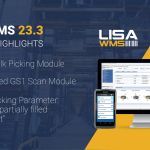
A modern Warehouse Management System (WMS) boosts business performance, streamlines inventory control, and lowers costs. Businesses often incorrectly assume that the cost of acquiring and managing a WMS outweighs the immediate or long-term benefits. This brief will help shed some light on justifying a Modern WMS from a return on investment (ROI) standpoint.
Obviously, each business assesses its unique needs for a WMS. Most are pleasantly surprised by the figures and benefits.
Key areas for justifying modern WMS: Inventory, Costs, and Customer Satisfaction. Benefits include accuracy, speed, and cost reduction. Which usually translates in the following high-level benefits:
- Inventory accuracy and real-time visibility
- Stocks level reduction
- Faster order fulfillment speed
- Lower warehouse and administrative labor costs
- Reduction of errors and returns
- Improved customer satisfaction
- Quicker employee training and onboarding
- Simplified compliance with regulated industries
Now, let’s dive into the ROI calculation of implementing a WMS.
Inventory Accuracy & Carrying Costs
Inventory carrying cost is the total of all the expenses tied to storing and managing products in your warehouse, these include depreciation, taxes, electricity insurance, etc. The carrying costs are usually expressed in a percentage of the overall inventory value, which is around 20-30% in many industries.
Carrying Costs = Inventory Value * Carrying Cost %
Inventory Value of $1,000,000 * 25% = $250,000 in Carrying Cost
Deploying features such as bar code scanning and cycle counting in a warehouse environment enables real-time visibility over stocks level and items location. Those features can drastically improve data accuracy, from 20% up to 99%. Accurate inventory lowers safety stocks, aiding inventory reductions from 5% up to 30%.
Average Inventory Reduction of 15% * $ 1,000,000 = $ 150,000 savings simply by reducing inventory levels (one time)
Inventory Reduction Savings of $150,000 * 25% in Carrying Cost = $ 37,500 gain in inventory carrying cost reduction (annually)
Total potential gain year 1 with inventory value of $1,000,000 = $150,000 + $37,500 = $187,500
Operational Costs Savings
A seamlessly integrated modern wms should normally boost employees’ productivity, reduce newcomers’ learning curve the and accelerate order fulfillment, allowing more to be done with the same resources. These are some of the features that should have the greatest impact on your workforce:
- Barcode scanning using RF technology is at least 9x faster than manual data entry
- Picking multiple orders at the same time
- The system guides operators using optimal routes to pick orders from the right locations through directed activities (put-away/picking).
- Carrier integration to calculate shipping rates automatically
- Cycle counting eliminating the need for physical inventories
Reduction in operating expenses can typically go up to 35%. So let’s take a look at the potential savings using an example where there are 10 employees in the warehouse with an average salary of $30,000 annually.
Annual operational costs of 10 warehouse workers at $300,000 * 35% in operational gains = $105,000 in potential operational cost savings
Customer Satisfaction & Shipping Errors
Shipping the wrong items, incomplete orders or inaccurate quantities can have serious impacts on a company’s bottom line. First, correcting the situation usually mean that the vendor will either reimburse partly or entirely the client, or will cover the costs of returning the misplaced goods (which triggers an entire process of quality check, repacking, put-away, etc.) and reship the initial order – handling a single return cost on average $200 to fix (which can greatly vary from one industry to another). Secondly, shipping the wrong order will usually have a direct impact on customer satisfaction, which can be huge if the client has been waiting for the item to complete an order for his own clients. We all heard that acquiring new clients can be 5 to 25 times more expansive than retaining existing ones, keeping the ones you have, that’s why the accuracy of orders shipped matters.
Statistically, a good data entry person makes 1 error every 300 keystrokes. With Radio Frequency technologies supported by a modern WMS, the number of errors drop to 1 in 3 million.
It is not uncommon for distribution centers to be able to reach up to 99.9% accuracy rate in order shipping when deploying a warehouse management solution. Let’s do the math for a warehouse facility shipping out 200 orders per week with an accuracy of 95% – prior to implementing a WMS.
200 orders * 5% inaccurate orders = 10 mistakes / week
10 errors * 52 weeks * $200 in costs to fix = $104,000 in costs caused by shipping errors
200 order * 0.1% inaccurate orders * 52 weeks * $200 = $2,080
$104,000 – $2,080 = $101,920 earn in cost savings annually
And this does not even include customer satisfaction, damage to your brand, or the cost of loosing a client!
Supply Chain Resilience & Business Growth
The growth of the business is vitally important to every business owner, CEO, president or GM. Getting the most out of employees, equipment, vendors, shipping partners and business systems is paramount for the healthy sustained growth needed to survive in our every changing economic environment. Becoming efficient in business practices will add tremendously to the ability to scale operations quickly when opportunities arise.
Additionally, reducing inventory levels, adopting just-in-time warehousing strategies and accelerating your order-to-cash cycle should increase the business cash-flows, increasing its capacity to innovate by investing in R&D, recruiting the best talents and ultimately become more competitive.
“Implementing a modern WMS brings about significant improvements in efficiency and cost savings.” advises Andre Walentowski, ERP Consultant at N’ware Technologies. “By leveraging advanced technologies such as machine data, predictive analytics, and anomaly detection, SMBs can unlock opportunities to optimize their warehouse operations, streamline processes, and achieve sustained growth. The rich data collected from the WMS enables businesses to make well-informed decisions and drive productivity on the shop floor.”
The adoption of a modern WMS such as LISA WMS for SAP Business One and ByDesign, offers substantial benefits to SMBs. LISA WMS allows SMBs to revolutionize their overall business performance.
Finally, to evaluate the ROI implementing a WMS in a warehouse environment is evaluating the overall acquisition cost. Reach out to our experts today to receive a ball-park estimate of deploying LISA WMS in your business.




